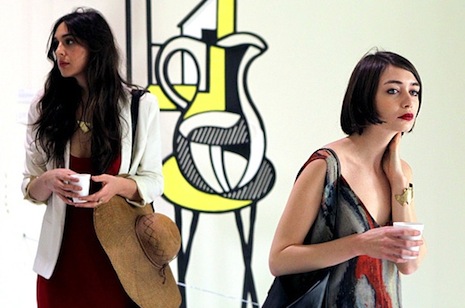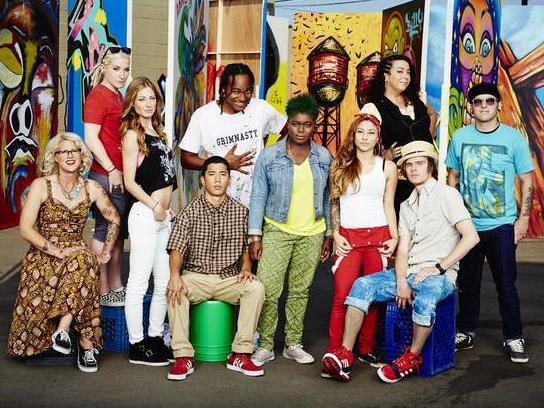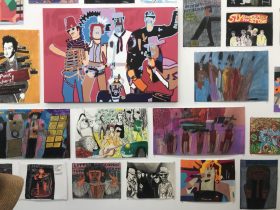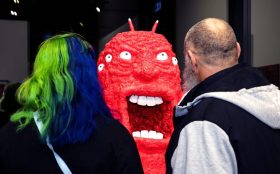The cast of Street Art Throwdown. Supplied: Oxygen
Contemporary art is not exactly known for its riveting mass appeal with television audiences. Studio practice doesn’t seem a match for the pace of today’s television viewing; the gallery scene not quite scathing enough for popular entertainment without spiraling into mere lampooning.
Yet many have accused the art world as not being “real”, and after several failed American attempts at art-themed series, a British production company might just have come up with the answer – Reality Street Art.
Will a show about Street Art contain the human drama and celebrity-factor to connect with the viewer on the couch? We take a look back at a chain of failed attempts at the genre’s foray into the art world to see if it can compete with the Kardashians.
The dismal wake
The explosion of the Reality TV genre in the late 1990s and early 2000s, driven globally by programs such as Survivor and Big Brother, meant that it was only a matter of time the “in-house” or “adventure competition” model permeated other categories. Over the past decade we have seen music, homemaking, dancing, food, dating, supermodels, court rooms, weight loss, subcultures, wife swaps and, yes, art unveiled in weekly episodes of real life entertainment.
First was Artstar (2006), driven by the mega American art dealer and curator Jeffrey Deitch. It lasted just one season.
We then were delivered by American cable network BRAVO, Work of Art: The Next Great Artist, which lasted two seasons (2010, 2011) and had a modest success for the network with ratings sitting at 1.2 million viewers.
Another attempt was made by BRAVO in 2012 with Gallery Girls, a “catty” behind-scenes take on New York’s art world through the lives of seven ambitious young women. It flopped, despite its cultish following by some for its appalling dialogue.
Now, the Brits are taking a stab at the art reality genre, using ten street artists as its pawn – the payoff? The chance to win $100,000. Street Art Throwdown started airing with Oxygen Media 3 February 2015.
The competition is key
Five years prior its predecessor, Work of Art: The Next Great Artist, also offered $100,000. Is it the golden number or is there no inflation within the world of reality TV?
It preyed on the competitive egos of 14 emerging artists and the alluring prestige of landing a solo exhibition at the Brooklyn Museum on top of the cash prize. Produced by Pretty Matches Productions and Magical Elves Productions, the same company that created the highly successful Top Chef, and niche Project Runway with its vying supermodels, Work of Art worked.
Casting is everything in the world of television. As a blog described: ‘14 sassy personalities – including a painter with a penchant for removing her top and an installation artist with obsessive-compulsive disorder – undertake the world’s most preposterous art commissions (Make a junk sculpture; you’ve got $100 and 48 hours.)’
Street Art Throwdown similarly works on the challenge model with the promotional tag of perhaps discovering the next Banksy. Its press statement said the show, ‘brings art to life with its groundbreaking, adrenaline-charged competition series.
‘The series tests not only their physical stamina, but also pushes their artistic skills to the limit in hopes of jump-starting their career…furiously scaling walls, climbing fences and navigating underground tunnels, these artists must have the talent, style and hustle to battle it out to the end.’
I didn’t realise art was a combat sport.
‘The artists on Street Art Throwdown are competing in a physical, emotional and creative journey to not only discover themselves as artists, but also catapult their careers with a life-changing grand prize,’ added Rod Aissa, Executive Vice President of Original Programming and Development, Oxygen Media.
Oxygen Media last foray into the art reality competition was Nail’d It (2014).
From what we can glean, Street Art Throwdown is largely set in Los Angeles. Ten of ‘America’s most talented street artists’ rise to the mini art-stunt challenge each week – The Hustle – confronted by environmental obstacles, before a final challenge – The Throwdown – the elimination round. It is like Survivor meets The Archibald.
The casting of the expert
Much of the pre-publicity of Street Art Throwdown relies on the show’s host – artist and designer Justin Bua, perhaps best known for his Nike and Target posters. It is hardly the same celebrity as Banksy, Bambi or even Shepard Fairey. The most “institutional” name is co-judge Lauren Wagner, director of Pop International Galleries (New York), and former Miami graffiti world aficionado.
Work of Art got it right. They turned to social media junkie, Pulitzer-prize art critic Jerry Saltz as judge, together with celebrity auctioneer Simon de Pury (who plays the role as mentor), dealer Jeanne Greenberg Rohatyn and actress-model-come-host China Chow, who had the roll of booting off a contestant each week with the cliché, ‘Your work of art didn’t work for us.’
No one wants to hear that line in the art world.
Its pre-publicity hinged on the fact that the show was co-produced by celebrity Sarah Jessica Parker, her “surprise” visit on set was totally unsurprising.
Artstar revolved around famed New York super-dealer Jeffrey Deitch; even criticised as erring on an infomercial for Deitch Projects. Rather than turning to the formulaic cliché of eliminating contestants each week or delving into salacious personal dramas, viewers watched as eight artists created individual artworks for a group exhibition with one offered the opportunity for a solo exhibition at Deitch Projects, which was reneged.
Deitch was quoted at the time: ‘In the 1970s…no self-respecting artist would have stood in line to try to get on a television show’.
When asked who would host such a show to Australian audiences, the answers weren’t all that surprising: Edmund Capon, Elizabeth Ann Macgregor, Ben Quilty, Andrew Frost, Tony Stephens and John MacDonald were the quick replies. The more entertaining ones – and savvy to art scene now – were: Glenn Barkley, Fleur MacDonald, Sarah Breen Lovett, Alexi Glass Kantor, Anneke Jaspers, Natasha Bullock, Deborah Edwards and Kon Gouriotis. Clearly we have no “tv type-cast” when it comes to the visual arts.
Artist Tracey Moffatt gave it a stab in her recent survey exhibition, which closes this week at the Gallery of Modern Art Brisbane (QAGOMA), her new video work Art Calls (2014) revolves around her playing a TV talk show host.
Salacious banter drives viewing drama
Gallery Girls largely dwelt on creating tv-stars out of nobodies, pawns to programming. The series followed the lives of young gallery professionals from Soho and Chelsea, Bushwick to Brooklyn; its episodes described as everything from ‘the petty brawling of young women in high heels as gladiatorial blood sport’ to ‘gallerinas’ who could ‘paper the white walls around them with their advanced art-history degrees…paid a pittance to do clerical work and look pretty.’

Gallery Girls; Supplied: Bravo Media.
What will our newest addition to this genre offer?
Aissa said: ‘Street Art is the most accessible art form there is— it takes art out of the galleries and into our everyday surroundings with themes reflecting our social and political climate as well as fun, vibrant, and bold forms of self-expression from those who create it.’
Early critics have argued that it is “cashing” in on the art markets embrace of graffiti artist Banksy. ’71 of the British street artist’s stenciled paintings, prints and sculptures have gone on the block at auctioneers like Sotheby’s, fetching a combined $4.67 million, according to Artprice, making 2014 the best year for Banksy’s market since its peak right before the recession.’
While these figures remain foreign concepts within the Australian art market, there is a currency of popularism with Banksy’s work – and street art generally – that bridges the art world with broader audience. More public would recognise the name Banksy than say the most recent winner of the Archibald prize.
Aissa’s comment also has a similar (television-friendly) ring as Saltz’s earlier comments on his role as judge, critic and arbiter of taste on Work of Art: ‘It’s art if the artist says it’s art…when I find myself going to [galleries in] Chelsea these days, I find that the art on our reality TV show is not much worse or much better.’
One of the reasons why art reality TV doesn’t sustain viewers is that it is unable to communicate the complexity of the ideas behind the work, rather taking the simplistic route of turning art into sport. We have reached no developments with that through this new attempt at the genre.
So does art rate?
In regard to the Brooklyn Museum’s involvement in Work of Art, columnist for art magazine Modern Painters Tyler Green had this to say: ‘It’s like the Harvard Business School turning over one of its classes to the contestants of [The Apprentice]. It’s a slightly pathetic departure from the best practices that govern the field.’
The partnership was heavily criticised by the art world at the time.
Bravo’s rebuttal: ‘Our sights are on broad viewers, people who like to have pretty pictures on their walls but might not know what goes into it,’ was the response of Frances Berwick, Bravo President.
We need little further proof. As the ratings start to role out over the next weeks, we will be amazed at the capacity for vacuous voyeurism to still compel people to watch. The big question, however, is will such a show (of version of it) make it to Australian shores; will we buy it in and would it have traction here?





